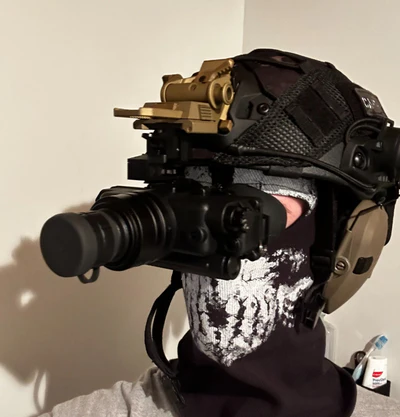Est. 2014 | USA Small Business
Night Vision Monoculars | PVS 14 & Tantos
Night Vision Monoculars | PVS-14 & Tanto
Introduction to Night Vision Monoculars
What is a Night Vision Monocular?
A night vision monocular is a device that enhances visibility in low-light conditions. It's a one-eyed gadget that uses various technologies to amplify the available light, whether it be starlight, moonlight or near-infrared light. The amplified light is then displayed on a screen inside the device, enabling the user to see in the dark.
Night vision monoculars are commonly used for activities such as wildlife observation, hunting, boating, and surveillance. They can also be employed by law enforcement and military personnel for operations conducted under the cover of darkness.
It's important to note that there are different generations of night vision technology, with each generation offering improved performance and image quality, but often at a higher cost. The most advanced night vision monoculars can provide clear, detailed images even in nearly total darkness
The History and Evolution of Night Vision Technology
Night vision technology has a rich history that dates back to World War II. The first night-vision devices were introduced in the German Army as early as 1939 and were developed by AEG starting from 1935. These early devices were primitive infrared devices3, and their use was primarily confined to the military since seeing in the dark provided a significant tactical advantage8.
The technology evolved significantly during the Vietnam War, when it came into widespread use2. This period saw the introduction of the first generation of passive night-vision technologies in the 1960s6. These devices were named "Starlight" because they were able to amplify the faint light from stars that was normally invisible to the naked eye6.
Despite the valuable capabilities these early night vision devices provided, they were hindered by their bulkiness5. Over time, enhancements in size, weight, power consumption, and cost have greatly improved the accessibility and utility of night-vision devices9.
Today, night vision technology has evolved beyond the battlefield. It's used for a wide range of applications, from wildlife observation and hunting to boating and surveillance. Furthermore, the technology continues to evolve, with each new generation offering improved performance and image quality.
How Does Night Vision Work?
Night vision works by amplifying the available light in the environment to make objects visible even in near-total darkness. The process involves several steps:
- Light Collection: The front lens, also known as the objective lens, collects ambient light from the surroundings, including the lower part of the infrared light spectrum that is not visible to the human eye.
- Conversion to Electrons: This collected light enters an image-intensifier tube, where it strikes a surface known as the photocathode. The photocathode converts the light into electrons.
- Amplification: These electrons then pass through a microchannel plate (MCP), where they are multiplied. The MCP is a disc with millions of short, parallel glass tubes that the electrons pass through, creating thousands of more electrons in the process.
- Conversion Back to Light: The amplified electrons hit a phosphor screen, which converts them back into photons (light particles). This screen displays green images because our eyes are more sensitive to green light and can distinguish more shades of green than any other color.
- Viewing the Image: The eyepiece magnifies the image on the phosphor screen so you can see it clearly. The image will appear as various degrees of green depending on the intensity of the reflected light.
It's important to note that there are different generations of night vision technology, each with a more advanced image-intensifier tube that provides better resolution, range, and low-light performance. Some night vision devices also use thermal imaging or active illumination technologies to further enhance visibility in the dark.
Types of NVG Monoculars
Gen 1, Gen 2, Gen 3, and Digital Night Vision Monoculars
Night vision monoculars come in different generations - Gen 1, Gen 2, Gen 3, and Digital - each offering varying levels of performance, image quality, and price points.
Gen 1 night vision devices are the earliest and most affordable. They use passive infrared technology to amplify available light7. However, they generally have a shorter battery life and offer less clarity and range compared to later generations6.
Gen 2 night vision devices represent a significant improvement over Gen 1. They feature a microchannel plate (MCP) for greater image amplification, resulting in better image quality and brightness4. They also have increased durability and adaptability, with three times longer life expectancy than Gen 1 devices2.
Gen 3 night vision devices are often used by the military and law enforcement due to their superior performance. They offer even better image resolution and light amplification, enabling clear visibility even in very low-light conditions9. Gen 3 devices also have a longer life expectancy than Gen 22.
Digital night vision devices, unlike the previous generations which use analog technology, convert the analog signal into a digital signal. This allows for features like video recording and the ability to view the image on different devices8. While they may not offer the same level of performance as Gen 2 or Gen 3 devices in extremely low-light conditions, they often provide adequate performance for general usage and can be more affordable5.
The cost of these devices can vary significantly. Prices generally start from $350 for a Gen 1 monocular, while Gen 2 monoculars can range from about $1000-$150017. The price for Gen 3 devices can be higher due to their advanced technology and superior performance1.
Infrared Illuminators in NightVision Monoculars
Infrared (IR) illuminators play a crucial role in night vision monoculars. These devices enhance the performance of night vision equipment in low light conditions or complete darkness4. IR illuminators emit infrared light, which is invisible to the human eye but can be detected by night vision devices7.
IR illuminators function similarly to flashlights for night vision devices, providing additional illumination that can dramatically increase night vision capability3. They are especially useful in indoor settings, wooded areas, and other environments where ambient light may be scarce3.
Many night vision monoculars come with built-in IR illuminators. For instance, the JStoon Digital Night Vision Monocular and the 1080P HD Monocular Night Vision Goggles both feature IR LED illuminators that allow clear viewing of targets up to 984 feet away in complete darkness12. Some devices also offer adjustable IR brightness levels for optimal visibility2.
In addition to built-in illuminators, there are standalone IR illuminators available that can be used with various night vision devices. Examples include the Armasight IR810 Infrared Illuminator, which is designed specifically for night vision monoculars68.
In summary, IR illuminators are key accessories for night vision devices, enhancing their functionality and performance in low-light conditions.
Thermal Imaging vs. Night Vision Monocles
Thermal imaging and night vision are two different technologies used for seeing in the dark, each with its own strengths and weaknesses.
Night Vision Monoculars work by amplifying available light, such as moonlight or starlight, to create an image. They use an image intensifier tube to amplify the faint light4. Night vision devices display images in shades of green because human eyes are more sensitive to green light. However, their effectiveness can be limited in absolute darkness or in situations where there is too much light, which can wash out the image6.
On the other hand, Thermal Imaging Monoculars detect differences in temperature and emit their own contrast, allowing them to see clearly both day and night2. They work by detecting the heat signatures of objects and converting this into an image. Everything emits some level of infrared radiation, and the hotter an object is, the more radiation it emits. This makes thermal imaging particularly effective for identifying living creatures in the dark1.
In terms of recognition and identification, night vision tends to be superior as it provides a more detailed image of the environment. However, thermal imaging is superior when it comes to detection, as it can easily spot heat signatures even through obstructions like smoke, fog, or foliage5.
Thermal imaging monoculars generally require less maintenance compared to night vision monoculars, but they often come with a higher initial purchase price3.
Ultimately, the choice between thermal imaging and night vision depends on the specific needs and circumstances of the user.
Choosing the Right Night Vision Monocular
Understanding Specifications: Magnification, Field of View, and Resolution
Understanding the specifications of optical devices like night vision monaclers, binoculars, or telescopes can greatly enhance your user experience. Three key specifications you often encounter are magnification, field of view, and resolution.
Magnification
Magnification is one of the most fundamental specifications. It indicates how much larger an object will appear compared to viewing it with the naked eye1. For example, a monocular with 10x magnification makes an object appear ten times closer than it would to the naked eye. A higher magnification will allow you to see more detail, but it can also make the image shakier if the device is handheld3.
Field of View
The field of view (FOV) is the width of the area you can see through the lens at a given distance, usually measured in feet at 1000 yards or meters at 1000 meters2. A larger field of view allows you to see a wider area, which can be beneficial for activities like bird watching or stargazing. However, a larger FOV often comes with lower magnification and vice versa4.
Resolution
Resolution refers to the level of detail that the lens can resolve, often determined by the quality of the optics and their ability to focus light5. Higher resolution provides a clearer, sharper image. In night vision devices, resolution is usually measured in lines per millimeter (lp/mm). A higher lp/mm indicates a higher resolution, meaning the device can distinguish finer details6.
In summary, understanding these specifications can help you choose the right device for your needs. Remember to consider the trade-offs: a device with high magnification might have a narrower field of view, and a device with a wide field of view might not provide the fine detail that comes with high resolution.
Durability and Weather Resistance
Durability and weather resistance are two critical factors to consider when choosing equipment that will be exposed to the outdoors, such as night vision or thermal imaging monoculars.
Durability refers to how well a product can withstand wear, pressure, or damage. In terms of optical devices, this often relates to the materials used in construction. For instance, monoculars made with rubber or metal bodies tend to be more durable than those made with plastic1. Moreover, the quality of the lens also contributes to durability. Lenses made from high-quality glass or coated for scratch resistance will likely last longer2.
Weather Resistance is the ability of a product to resist the effects of weather conditions. This usually includes resistance to water (rain or snow) and dust. Weather-resistant monoculars typically have seals to prevent moisture or dust from entering the device3. Some products are fully waterproof, meaning they can be submerged in water without damaging the internal components4.
Many manufacturers use the IP (Ingress Protection) rating system to indicate a product's level of protection against solids and liquids5. For example, an IP67-rated device is dust-tight and can withstand being submerged in up to 1 meter of water for 30 minutes6.
Remember that while durability and weather resistance are important, they should be considered alongside other factors like image quality, magnification, field of view, and resolution when choosing a monocular or any similar device.
Applications of Night Vision Monoculars
Night Hunting and Wildlife Observation
When it comes to night hunting and wildlife observation, certain features and specifications of optical devices become particularly important.
Night Vision: For activities in low-light conditions, night vision capability is crucial. Night vision devices work by amplifying available light (such as moonlight or starlight) to create a visible image1. Some devices use thermal imaging, which detects the heat emitted by animals to form an image2.
Magnification and Field of View: A balance between magnification and field of view is important for night hunting and wildlife observation. High magnification allows you to see distant animals clearly, but it also narrows your field of view, making it harder to spot moving animals3. A wider field of view allows you to monitor a large area, but objects will appear smaller.
Durability and Weather Resistance: Outdoor activities at night can expose your equipment to various elements, including moisture and cold temperatures. Therefore, durability and weather resistance are important considerations4.
Quiet Operation: For wildlife observation and hunting, it's essential that your device operates quietly so as not to disturb the animals5.
Battery Life: Since hunting and wildlife observation can take several hours, long battery life is a key factor to consider when choosing a device6.
Nighttime Navigation and Hiking
Nighttime navigation and hiking present unique challenges, but with the right equipment, these activities can be safe and enjoyable. Here are some key considerations when selecting optical devices for these purposes:
- Night Vision Capability: For nighttime navigation and hiking, a device with night vision capability is crucial. These devices work by amplifying available light from the moon, stars, or artificial sources to create a visible image1.
- Field of View and Magnification: A wider field of view can be beneficial for hiking as it allows you to see a larger portion of your surroundings at once. However, a balance between field of view and magnification should be achieved as higher magnification narrows down the field of view2.
- Durability and Weather Resistance: Devices used for hiking should be durable enough to withstand tough conditions and accidental drops. They should also be weather-resistant to protect against rain, snow, and dust3.
- Compact and Lightweight: Since you'll likely be carrying the device for extended periods, it should be lightweight and compact for easy portability4.
- Long Battery Life: Battery life is another important consideration for nighttime navigation and hiking. The device should have sufficient battery life to last throughout your activity5.
- Additional Features: Some devices come with additional features like compasses, GPS, and rangefinders, which can be particularly useful for navigation6.
Security and Surveillance
Security and surveillance are key areas where optical devices play a crucial role. Here's what to consider when selecting devices for these purposes:
- Night Vision Capability: Many security and surveillance activities occur during low-light or nighttime conditions. Devices with night vision capability, which amplify available light to create a visible image, are essential1. Some devices also use thermal imaging, detecting heat emitted by people or objects to form an image2.
- Field of View and Magnification: A wide field of view allows you to monitor a large area at once, while high magnification lets you observe details at a distance. The best balance between these features depends on your specific surveillance needs3.
- Durability and Weather Resistance: Surveillance equipment often needs to withstand various weather conditions, making durability and weather resistance important considerations4.
- Image Quality and Resolution: High-quality images can be critical in identifying individuals or objects. Devices with high resolution can provide clearer and more detailed images5.
- Recording Capability: Some optical devices come with the ability to record video or take photos, which can be useful for maintaining records or evidence6.
- Connectivity: Devices that can connect to a network or other devices—allowing for remote viewing or control—can add another layer of convenience and functionality7.
Care and Maintenance of Night Vision Monoculars
Cleaning and Storage Tips
Proper cleaning and storage of your optical devices can significantly extend their lifespan and ensure optimal performance. Here are some tips:
Cleaning Tips:
- Use a Lens Brush: Use a lens brush to gently remove dust and debris from the lenses. Brushes designed specifically for lens cleaning are best as they have soft bristles that won't scratch the lens surface1.
- Lens Cleaning Solution: For stubborn dirt or fingerprints, use a special lens cleaning solution. Never use household cleaning products, as they can damage the lens coatings2.
- Microfiber Cloth: Use a microfiber cloth to clean the lens after applying the cleaning solution. Microfiber cloths are gentle on the lens and do not leave lint behind3.
- Clean Exterior with a Damp Cloth: Wipe the exterior of your device with a slightly damp cloth. Avoid getting moisture near the lenses or inside the device4.
Storage Tips:
- Store in a Dry Place: Moisture can damage your device, causing mold and fungus to grow on the lenses. Always store your device in a dry place5.
- Use a Protective Case: A protective case will shield your device from dust and impact damage. Some cases also have padding for extra protection6.
- Avoid Extreme Temperatures: Extreme cold or heat can damage your device. Try to store it at room temperature whenever possible7.
- Remove Batteries: If you're not going to use your device for a long time, remove the batteries to prevent leakage and corrosion8.
Battery Life and Power Solutions
Battery life is a crucial aspect of the best monocular night vision, especially those used for extended periods or in remote locations. Here are some tips on maximizing battery life and finding power solutions:
- Use High-Quality Batteries: High-quality batteries often provide longer life and more reliable performance. Lithium batteries, for instance, can perform well even in cold temperatures1.
- Turn Off When Not in Use: To conserve power, turn off your device when it's not in use. Some devices also have power-saving modes that automatically switch off after a certain period of inactivity2.
- Adjust Settings: Lowering the brightness of illuminated reticles or screens, disabling Wi-Fi or Bluetooth when not needed, and minimizing the use of additional features can help extend battery life3.
- Carry Spare Batteries: Always carry spare batteries, especially during long trips or when using your device extensively. Consider investing in a battery case for safe and convenient storage4.
Power Solutions:
- Solar Chargers: Solar chargers can be a great solution for recharging batteries during extended trips. These chargers convert sunlight into electricity and can recharge most standard batteries5.
- Power Banks: Power banks are portable battery chargers that can recharge your device multiple times. They come in various sizes and capacities6.
- Vehicle Chargers: If you're traveling by vehicle, consider bringing a car charger. These chargers plug into your vehicle's cigarette lighter or USB port to recharge your device7.
Common Issues and Troubleshooting
Optical devices can sometimes encounter issues that affect their performance. Here are some common problems and their potential solutions:
- Blurry Image: This is often caused by an unclean lens or improper focus. Clean your lens carefully with a lens brush or microfiber cloth. If the image remains blurry, adjust the focus1.
- Double Vision: This problem usually occurs in binoculars when the two barrels are not properly aligned. This issue, known as collimation, often requires professional repair2.
- Moisture Inside the Lens: This can happen if your device has been exposed to high humidity or drastic temperature changes. Use silica gel packs to absorb moisture and store your device in a dry place3.
- Poor Night Vision Performance: This could be due to low battery power or ambient light levels that are too high or too low. Ensure your batteries are fully charged and try to use the device under different lighting conditions4.
- Device Not Powering On: Check your batteries and replace them if necessary. If your device still doesn't turn on, it may have a more serious issue that needs professional attention5.
Filters
-
AN/PVS-14 | Gen 3 White Phosphor | U.S. Military Standard Monocular
Original price $3,744.95 - Original price $5,563.95Original price $3,744.95 - Original price $5,563.95Original price $3,744.95From $2,499.00$2,499.00 - $5,599.00Current price $2,499.00| /AN/PVS-14: 350m detection range to Pierce conditions of extreme darkness. The AN/PVS-14, aka PVS-14, is the battle-proven night vision monocular u...
View full details -
Nocturn Industries Tanto | 7.52oz Gen 3 WP Monocular | 50-Hr Runtime
Original price $3,744.95 - Original price $5,456.95Original price $3,744.95 - Original price $5,456.95Original price $3,744.95From $2,799.00$2,799.00 - $5,799.00Current price $2,799.00| /UANVM Tanto | 50 hours of continuous operation at only 7.52 Oz The Nocturn Industries UANVM Tanto is an ultralight night vision monocular engineer...
View full details -
Armasight PVS-14 Gen 3 Night Vision Monocular w/ 3x Lens, Thin-Filmed White Phosphor Tube
Original price $4,499.00 - Original price $5,499.00Original price $4,499.00 - Original price $5,499.00Original price $4,499.00From $3,999.00$3,999.00 - $4,899.00Current price $3,999.00| /Armasight PVS-14 Gen 3 Night Vision Monocular – Durable, High-Resolution, and Built for Extreme Conditions The Armasight PVS-14 Gen 3 Night Visio...
View full details -
Armasight PVS-14 Gen 3 Bravo Night Vision Monocular w/ 3x Lens
Original price $3,999.00 - Original price $3,999.00Original price$3,999.00$3,999.00 - $3,999.00Current price $3,999.00| /Armasight PVS-14 Gen 3 Bravo Night Vision Monocular with 3x Lens – Durable, High-Performance Optics for Extreme Conditions The Armasight PVS-14 G...
View full details -
RVM-14 | Gen 3 White Phosphor | 15% Lighter & 50% Longer Batt vs PVS-14
Original price $5,349.95Original price $5,349.95 - Original price $5,349.95Original price $5,349.95From $2,599.00$2,599.00 - $5,599.00Current price $2,599.00| /RVM-14 | Made from aircraft-grade aluminum, 15% lighter than a PVS-14. The RVM-14 is a ruggedized night vision monocular designed for operators wh...
View full details -
Armasight 6x Magnifier Lens for PVS-14
$299.00Original price $299.00 - Original price $299.00Original price $299.00$299.00$299.00 - $299.00Current price $299.00| /Armasight 6x Magnifier Lens for PVS-14 – Enhance Long-Range Night Vision with Precision and Ease The Armasight 6x Magnifier Lens is a powerful ac...
View full details -
Armasight PVS-14 J-Arm Dovetail Adapter
$129.00Original price $129.00 - Original price $129.00Original price $129.00$129.00$129.00 - $129.00Current price $129.00| /Armasight PVS-14 Dovetail J-Arm Adapter: Reliable, Modern Mounting for Hands-Free Night Vision The Armasight PVS-14 J-Arm Dovetail Adapter is a d...
View full details -
Armasight 3x Magnifier Lens for PVS-14
$199.00Original price $199.00 - Original price $199.00Original price $199.00$199.00$199.00 - $199.00Current price $199.00| /Armasight 3x Magnifier Lens for PVS-14 - Long-Range Night Vision Enhancement for Professionals High-Performance Afocal Lens: Converts your night ...
View full details -
Armasight Magnifier Lens Bundle for PVS-14
$498.00Original price $498.00 - Original price $498.00Original price $498.00$498.00$498.00 - $498.00Current price $498.00| /Armasight Magnifier Lens Bundle for PVS-14 – Extend Your Night Vision Range with Precision The Armasight Magnifier Lens Bundle is designed to enh...
View full details -
Armasight PVS-14 Gen 3 + Sidekick Kit
Original price $0.00 - Original price $8,999.00Original price $0.00 - Original price $8,999.00Original price $8,499.00From $0.00$0.00 - $7,899.00Current price $0.00| /Armasight PVS-14 Gen 3 + Sidekick Kit: Advanced Night Vision and Thermal Imaging for Ultimate Precision Comprehensive Night Vision and Thermal So...
View full details -
Armasight PVS-14 Gen 3 High Performance Night Vision Monocular w/ 3x Lens
$4,499.00Original price $4,499.00 - Original price $4,499.00Original price $4,499.00$4,499.00$4,499.00 - $4,499.00Current price $4,499.00| /Armasight PVS-14 Gen 3 Night Vision Monocular – Compact, Durable, and Feature-Packed for Unmatched Clarity The Armasight PVS-14 Gen 3 High-Perfor...
View full details -
Armasight PVS-14 Gen 3 Pinnacle Elite Night Vision Monocular
Original price $5,499.00 - Original price $5,999.00Original priceFrom $5,499.00$5,499.00 - $5,999.00Current price $5,499.00| /Armasight PVS-14 Gen 3 Pinnacle Elite Night Vision Monocular - Durable, High-Performance Optics with Exceptional Battery Life The Armasight PVS-1...
View full details -
Armasight PVS-14 Gen 3 Pinnacle Night Vision Monocular
Original price $5,099.00 - Original price $5,399.00Original priceFrom $5,099.00$5,099.00 - $5,399.00Current price $5,099.00| /Armasight PVS-14 Gen 3 Pinnacle Night Vision Monocular – Rugged, Reliable, and Built for Extreme Conditions Multi-functional Design: The PVS-14 c...
View full details
No catches. Always in the USA.
Guaranteed Secure Payment. SSL AES-256.
Certified products. Certified and trusted shipping.
Family owned and operated in the USA.
Professionals Trust Atomic Defense





What People Like You Are Saying

11/10! The small touches made such a big impact, like the patch, stickers and jolly ranchers were something I am beyond grateful for! Amazing product! Great price, very much satisfied.
C. Nelson

If you want updates regularly, just shoot Atomic Defense a message. They always respond quickly and answer any questions you have and can clarify. (*Modified for read-ability and formatting.)
S. Stocker

It's comfortable, like 8.9/10. I'm happy I went with Atomic Defense. Genuine equipment you can trust your life with.(*Modified for read-ability and formatting.)
C. Flick













































